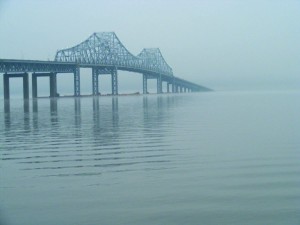
The Tappan Zee Bridge winds its way into conversations from time to time around these parts.
The subject comes up when someone jumps off or traffic ties up. Or another repair job is ordered and dollars fly away as fast as those pesky punch holes appear on the 3-mile span connecting Westchester and Rockland counties.
We”™ve covered the bridge extensively in the Business Journal, both from the news side on the countless studies and recommendations for a new bridge, and on this page in questioning the length of time and mounds of cash being spent on quick fixes.
We even hosted a roundtable discussion with heads of various business, trade and environmental groups. We outlined the alternatives, debated the mass-transit options and winced at the costs.
Several weeks after, while dining with colleagues at Sunset Cove in Tarrytown, we gazed out the window at the structure. It was around 6:30 p.m. and mist over the Hudson River was rising around the bridge, like a shroud. Rockland wasn”™t visible. Neither was the north end of the bridge ”“ it appeared to be sinking into the choppy, murky waters. An omen?
We agreed it was eerie. One of our colleagues went to fetch his camera and came back with the shot printed here.
We also printed that photo at the time, to accompany an opinion piece in which we bemoaned the delays in coming up with a plan for the bridge:
“Build the bridge already. If it”™s not economically feasible to include the mass-transit component simultaneously, fine, build the bridge anyway. Just make sure it has the capacity to add a rail or other mass-transit component in the future.”
We also called for someone to spearhead the project:
“Someone must take the lead in pushing the project forward. We cannot afford this snail”™s pace. Costs will keep rising, punch holes will continue forming and traffic will keep piling up. This project is too important ”“ it extends beyond this region.
Let”™s get moving.”
That was April 14, 2008.
And here we are, in the dogs days of 2011, and no closer to a solution than we were three years ago.
If the consensus is the bridge needs to be replaced for both economical and safety reasons ”“ the Federal Highway Administration found it to be “structurally deficient” ”“ what”™s the problem?
What”™s holding it up, figuratively speaking?
It”™s not very sexy. Infrastructure rarely is. Except, of course, when something collapses and people die.
But on any given day, bridge talk certainly will not get the same reaction as, say, a nuclear reactor. Yes, any mention of Indian Point is sure to radiate with the “shut ”™em down” crowd.
And now the governor has put his imprimatur on that statement. This comes as little surprise, however. Andrew Cuomo has long been vocal in his opposition to the nuclear power plant in Buchanan.
As of now, however, nuclear plants are a matter for federal oversight and states have limited abilities when it comes to controlling the operations of such facilities.
We”™ll have to wait and see on this one.
In the meantime, the governor has been called to action on the Tappan Zee Bridge.
At a recent conference in Manhattan, Westchester County Executive Robert Astorino implored Cuomo to take a leadership position in getting a new bridge built.
“The practical and political reality is that rebuilding the Tappan Zee Bridge must be a priority of the governor,” Astorino said. “”¦ because he more than anyone else controls the levers and resources of government to get the job done.”
We agree. Following a productive legislative session, we”™d rather see the governor and his team focus on replacing the Tappan Zee Bridge than on closing Indian Point. We”™re not going to debate the safety issues on the plant; there are more than enough “authorities” eager to weigh in on that.
We”™re strictly business here and we make no bones about it.
Our concerns lie with commerce and economic development, not just for the foreseeable future but for generations down the road. And to our eyes, the Tappan Zee Bridge is a vital artery in the region”™s commerce system.
As it stands now, a new bridge would cost upward of $16 billion (in 2011 dollars). In terms of funding, a public/private partnership is an idea worth pursuing. Taxpayers should not be expected to shoulder the burden alone.
And the federal government needs to be called in as well. There are some federal dollars floating around following Florida Gov. Rick Scott”™s decision to decline $2 billion for high-speed rail in the Sunshine State. In fact, the feds say $785 million of that money will be distributed to Northeast Corridor projects.
Perhaps we can cash in on some of that ”“ certainly U.S. Sen. Charles Schumer could lend a hand here.
A new Tappan Zee Bridge will be an enormous financial undertaking. But further delays will only serve to add to the cost.
It”™s time to stop studying the bridge and start mapping out a serious plan to replace it.

















